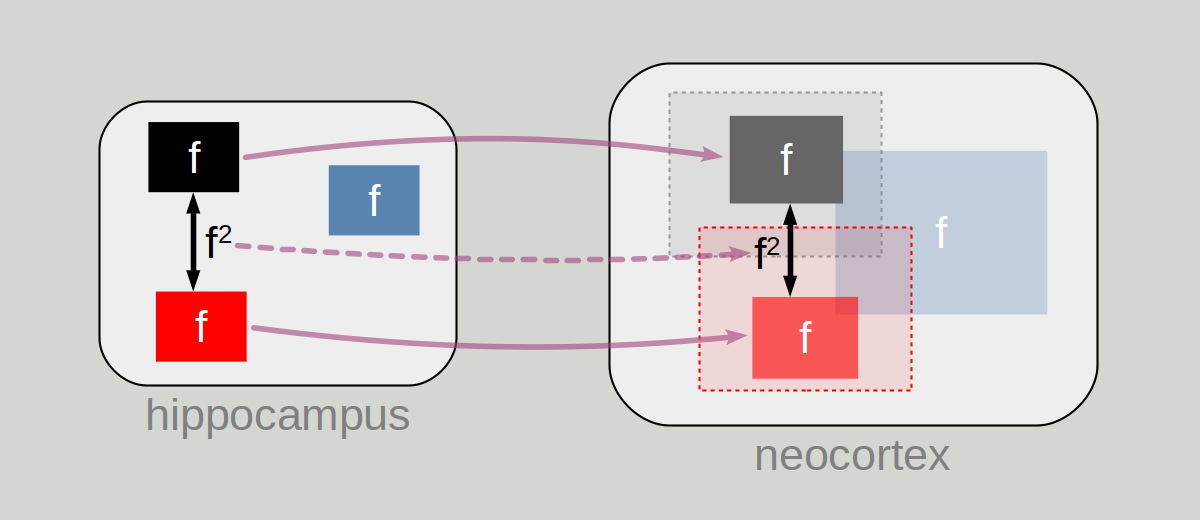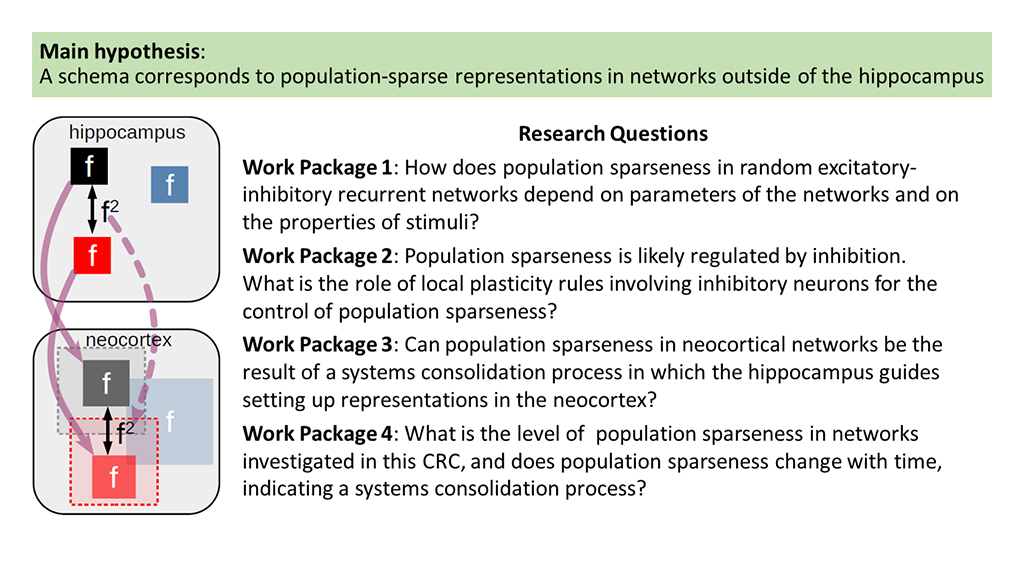B01
Ein neuronales Modell für die Entwicklung von Schemas und ihre Rolle bei der systemischen Gedächtniskonsolidierung

Das Erlernen und die Konsolidierung von deklarativen Gedächtnisinhalten ist wesentlich leichter, wenn neue Inhalte konsistent sind mit bereits vorhandenem Wissen. “Schemas” beschleunigen nicht nur neues Lernen, sondern fördern auch Plastizität in Hirnregionen außerhalb des Hippocampus. Unklar ist, welche neuronale Repräsentationen einem Schema zugrunde liegen und wie sie zustande kommen. Wir schlagen vor, dass ein Schema durch spärliche neuronale Aktivität in Netzwerken außerhalb des Hippocampus gekennzeichnet ist. Ziel dieses Projekts ist deshalb zu verstehen, wie hohe Populationsspärlichkeit für besonders wichtige Gedächtnisinhalte entstehen könnte.
Graphical Abstract
 Graphical abstract: Schemas and neural representations. Top: In hippocampus-like networks, representations are sparse. The small size of bright-colored boxes indicates the small fraction f of highly active neurons representing items. Sparse representations allow fast (“one-shot”) learning of an association between two items because the fraction of synapses involved is proportional to f2 (black double-headed arrow). Bottom: Neocortex-like networks with distributed representations (pale colored boxes indicate active neurons) require slow or “interleaved” training to avoid catastrophic interference with other memories. We propose that some representations become sparser through processes related to systems memory consolidation (magenta solid arrows), which allows faster learning and faster consolidation (magenta dashed arrow).
Graphical abstract: Schemas and neural representations. Top: In hippocampus-like networks, representations are sparse. The small size of bright-colored boxes indicates the small fraction f of highly active neurons representing items. Sparse representations allow fast (“one-shot”) learning of an association between two items because the fraction of synapses involved is proportional to f2 (black double-headed arrow). Bottom: Neocortex-like networks with distributed representations (pale colored boxes indicate active neurons) require slow or “interleaved” training to avoid catastrophic interference with other memories. We propose that some representations become sparser through processes related to systems memory consolidation (magenta solid arrows), which allows faster learning and faster consolidation (magenta dashed arrow).
Team
-

Prof Dr Benjamin Lindner
Humboldt-Universität zu Berlin & BCCN
Head of the group Theory of Complex Systems and Neurophysics
-

Prof Dr Richard Kempter
Humboldt-Universität zu Berlin
Deputy Spokesperson, Head Theoretical Neuroscience Lab
-

Prof Dr Henning Sprekeler
Technische Universität Berlin
Head Sprekeler Lab - B01 Alumnus PI
-

Jakob Stubenrauch
Humboldt-Universität zu Berlin & BCCN
B01 PhD (AG Lindner)
-

Naomi Auer
Humboldt-Universität zu Berlin
B01 PhD
-

Ikhwan Khalid
Humboldt-Universität zu Berlin
B01 PhD (AG Kempter)
-

Lars Chen
Humboldt-Universität zu Berlin
B01 Student helper
-

Denis Alevi
Technische Universität Berlin
B01 Associate PhD
-

Dr Tiziano D’Albis
Humboldt-Universität zu Berlin
B01 Alumnus
-

Dr Eric Reifenstein
Humboldt-Universität zu Berlin
B01 Alumnus
Publications
Population sparseness determines strength of Hebbian plasticity for maximal memory lifetime in associative networks
Naomi Auer, Lars Chen, Jakob Stubenrauch, Benjamin Lindner, Richard Kempter
bioRxiv (2025)
Furutsu-Novikov–like cross-correlation–response relations for systems driven by shot noise
Jakob Stubenrauch and Benjamin Lindner
Phys. Rev. X 14, 041047 (2024)
Quantitative modeling of the emergence of macroscopic grid-like representations
Ikhwan Bin Khalid, Eric T. Reifenstein, Naomi Auer, Lukas Kunz, Richard Kempter
eLife (2024)
Intra-ripple frequency accommodation in an inhibitory network model for hippocampal ripple oscillations
Natalie Schieferstein , Tilo Schwalger, Benjamin Lindner, Richard Kempter
PLoS Comput Biol. 20(2): e1011886 (2024)
Hebbian plasticity in parallel synaptic pathways: A circuit mechanism for systems memory consolidation
Michiel Remme, Urs Bergmann, Denis Alevi, Susanne Schreiber, Henning Sprekeler, Richard Kempter
PLOS Comput Biol 17(12):e1009681 (2021)
A neural code for egocentric spatial maps in the human medial temporal lobe
Lukas Kunz, Armin Brandt, Peter C. Reinacher, Bernhard P. Staresina, Eric T. Reifenstein, Christoph T. Weidemann, Nora A. Herweg, Ansh Patel, Melina Tsitsiklis, Richard Kempter, Michael J. Kahana, Andreas Schulze-Bonhage, Joshua Jacobs
Neuron. 109(17) 2781-2796.e10 (2021)
Microcircuits for spatial coding in the medial entorhinal cortex
John J Tukker, Prateep Beed, Michael Brecht, Richard Kempter, Edvard I Moser, and Dietmar Schmitz
Physiol Rev. 102:653–688 (2022)
Synaptic learning rules for sequence learning
Eric T. Reifenstein, Ikhwan Bin Khalid, Richard Kempter
eLife. 10:e67171 (2021)
Learning accurate path integration in a ring attractor model of the head direction system
Pantelis Vafidis, David Owald, Tiziano D'Albis, Richard Kempter
eLife 11:e69841 (2022)

Propofol modulates early memory consolidation in humans
Daa Un Moon, Nazli Esfahani-Bayerl, Carsten Finke, Daniel J Salchow, Mario Menk, Simon Bayerl, Richard Kempter and Christoph J Ploner
eNeuro. 7(3):ENEURO.0537-19.202
Recurrent amplification of grid-cell activity
Tiziano D'Albis and Richard Kempter
Hippocampus. 30(12):1268-1297 (2020)

